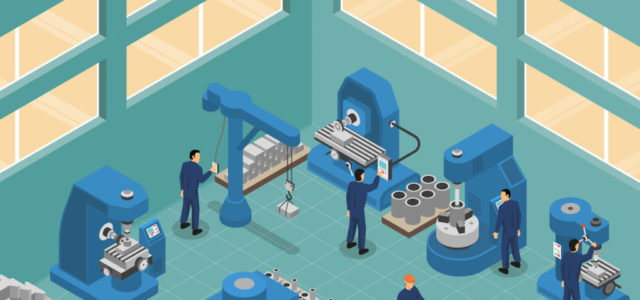Decoding the workflows of the digital workforce has been the goal of millions of people since the introduction of the computer in business operations. Visual Process Discovery tools seemed to be the answer to peek into the work lives of our employees. Discover why this decade old idea just did not live up to the hype.
Why Process Discovery Matters
To managers, analysts and developers, there is enormous potential locked in business processes concealed by digital work. If these process insights and information can be easily revealed then that data can be a value multiplier to business operations.
Digital transformation, business process improvement, workflow standardization and automation are goals for every modern business. But
they are being hobbled by a lack of progress and insights being delivered by current Process Discovery technology.
The most common (and oldest) method of Process Discovery is the manual recording of workflows, which is physically watching and interviewing workers. This is obviously intrusive, labor intensive, and costly. The only way to unlock the true value of Process Discovery is to automate the Process Discovery process.
The most innovative method of Process Discovery that most Process Intelligence firms are selling, uses captured images from users’ screens. We see this method as outdated and rather Un-Intelligent, and we will show you why.
Visual Process Discovery – Why it fails
Is it faster to download a text file or an image? You either know this through personal experience or you can easily do the research. This information is fundamental computer knowledge.
A regular picture can take up to 4 megabytes of space while a single page text document is around 12 kilobytes of space. That means it takes a computer 1000 times more storage, processing, energy, and time to download an image than it does a document. If your product relies on the upload/download of data then what you are relaying (documents or images) is very, very important to your costs because storage, processing power, and energy cost money.
Visual Discovery captures screenshots from user computers and then uses OCR (Optical Character Recognition) to find similarities, clustering those similarities and discovering patterns. These patterns are tasks or processes which make up the digital workflows of an organization.
Hidden Costs and Massive Slow-Downs
Knowing the difference between downloading an image or a text file is essential to understanding the costs and effectiveness of different Process Discovery tools. Downloading images is exponentially harder than downloading documents, it takes enormous bandwidth and storage, slowing down your existing systems and increasing your operational costs.
This enormous cache of accumulated data then takes much more computing power to sift through and process than text based information. But with this knowledge, why are most of the Process Discovery tools on the market based on screenshots, OCR and Visual Discovery? – It’s outdated technology that is ready for a change!
Visual Process Discovery was a good idea, but it hasn’t worked based on evidence from a decade of it being on the market. Images are too big and the costs associated with processing large amounts of data make the ROI of Visual Process Discovery inaccessible.
UiPath’s new release underlines the outrageous data demands of Visual Process Discovery
We were interested when UIPath recently released their version of Process Discovery. We were disappointed to find it is virtually the same as any other solution already on the market. Uipath clients do have the added benefit of having RPA tools and Process Discovery tools through the same provider. But it isn’t an internet breaking release like some expected.
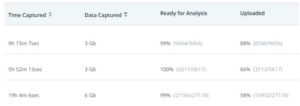
A Graph of UiPath Visual Process Discovery Data collection over a week.
Uipath also released their technical guide which highlights the problem with Visual Process Discovery. They show in their guide that they collect 3Gb of data for every 6 to 9 hours of work.
If they were collecting data from 25 employees for 60 days that would be 4.5 terabytes of data. That data would have to be collected, stored, processed, cleaned, and analyzed. Just transferring that much data would take 400 hours!
Now try to scale this up to collecting data for years and/or for hundreds or thousands of employees.
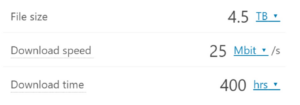
Amount of time taken to transfer Visual Process Discovery data for 2 months of collection.
This is a prime example of how Visual Discovery will never be scalable for enterprise.
It is important to remember that this is the newest Process Discovery tool, from the largest Robotic Process Automation provider. Which all other RPAs are replicating.
Is everything on your computer image based? – What’s being missed?
No, everything on your computer is not image based. So much of what happens on your computer does not show up on the screen.
Your physical interactions with your computer are translated into machine language which cause the computer to perform different functions. The actions that your computer takes to perform a function takes place in the software and the hardware and goes unseen.
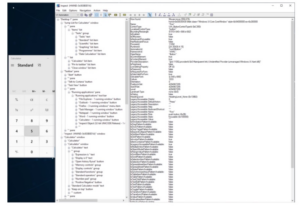
Image of the code that goes on behind the scenes when using computer software.
A lot of what happens on your computer does not take place on the screen. Not being able to capture this background information means that we are not seeing the complete picture of processes and lacking a defined context.
Visual Process Discovery captures too much of the wrong information.
OCR and images are good and necessary, but they are only one part of understanding the end-to-end process. If one of the end goals of Process Discovery is automation then it needs to produce information that is useful to an RPA developer. This includes the process details that are not shown on the screen. Is this just our opinion or is this sentiment becoming more prevalent?
Blueprint Industry Report
Late 2021, Blueprint published an industry report where they listed the top challenges of Process Discovery. Blueprint surveyed 400 executives for their industry report. They listed a score of issues, many of which would seem to stem from the level of outdated technology currently being used. Costs, effort, security, too much data, and intense time requirements, are key signs that the technology being utilized is under delivering.
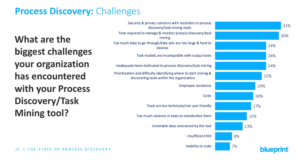
Blueprint industry report demonstrating the shortfalls of Visual Process Discovery
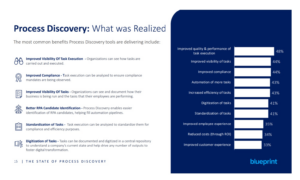
Blueprint Report shows the need for Intelligent Process Discovery
Blueprint’s report underlined the need for Process Discovery in the industry. They also show that the current demand is not being met by the existing technology. Their report demands that current technology be reworked and new ideas need to be tried. We at OfficeAutomata have taken up the challenge and developed a new system to meet the needs of modern businesses. Our innovative Intelligent Process Discovery system eliminates the key challenges uncovered by the Blueprint study and leads businesses more directly to automation success.
Conclusion: Most Process Discovery solutions on the market are legacy systems copying the same stagnate ideas
The current methods of performing Process Discovery are, at the same time, gathering too much data and not enough it. At least, not enough of the right data to effectively get all the right background and cross-departmental information. This means that process models and task maps produced from Visual Discovery fail to create a complete picture of the end-to-end process. It lacks the context needed to facilitate understanding and automate repetitive processes.
The right solution needs to be able to collect important process details from all the users and all the departments all the time. It needs to collect the right information that is important to RPA developers to produce persistent automations. A true Process Discovery solution will connect all the sources of data in one server; Process Mining, OCR, and user event data. Its outputs must be understandable to the humans who manage these businesses and the automation softwares that they will employ.
Article by channel:
Everything you need to know about Digital Transformation
The best articles, news and events direct to your inbox
Read more articles tagged: Automation






